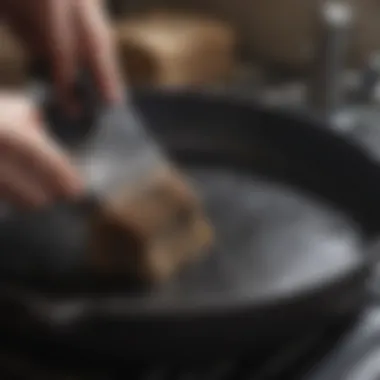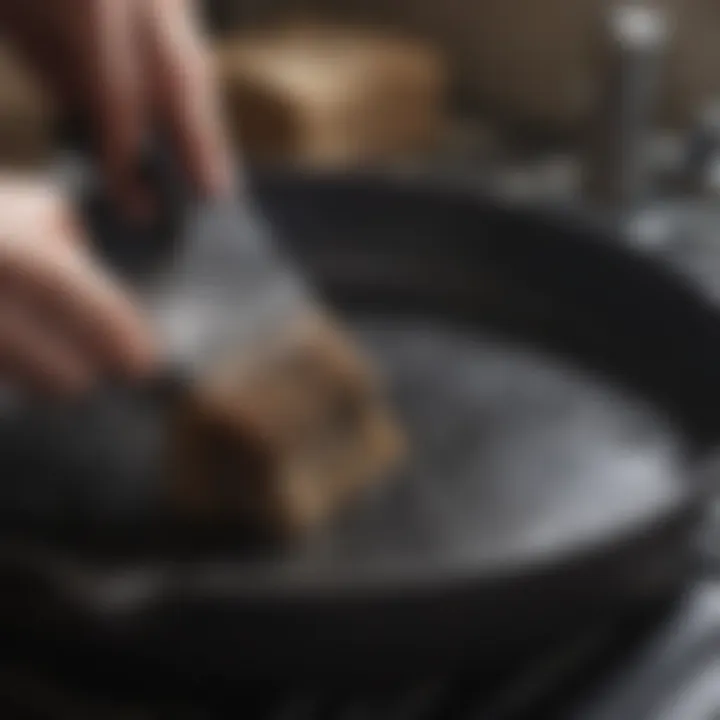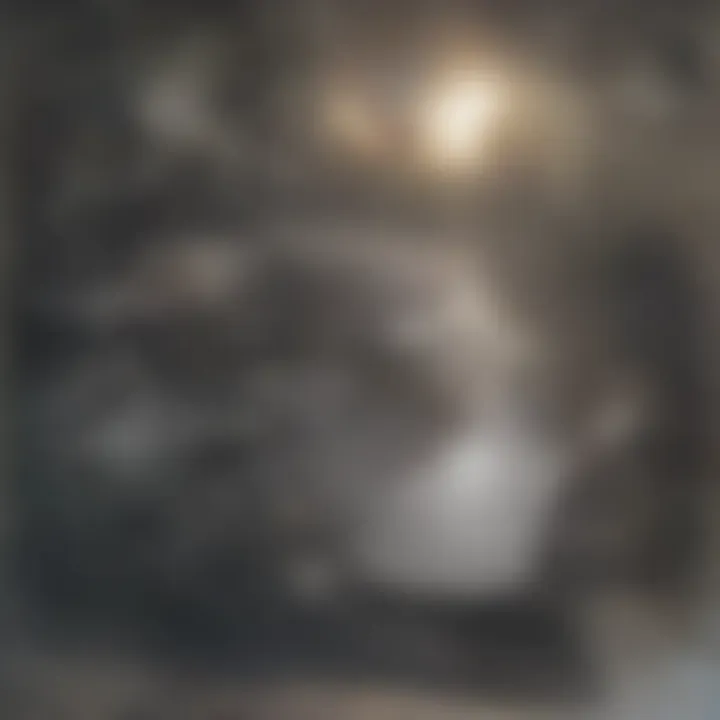Mastering the Art of Washing Cast Iron Pans


Intro
Cast iron pans are cherished staples in many kitchens, revered for their durability and heat retention. However, they require a nuanced approach to cleaning and care that distinguishes them from typical cookware. Understanding these methods is essential for both novice and seasoned cooks who wish to preserve the integrity and performance of their cast iron pans.
Improper cleaning techniques can lead to rust, a stripped seasoning layer, and a pan that no longer delivers the superior cooking experience it promises. This guide aims to dissect effective washing methods while promoting an in-depth understanding of how to maintain the cookware's longevity. With insightful tips and practical strategies, readers can keep their cast iron pans in top condition, ensuring each meal cooked represents a blend of tradition and functional artistry.
Understanding Cast Iron Cookware
Understanding cast iron cookware is essential, particularly in the context of maintenance and proper cleaning strategies. This type of cookware has stood the test of time, not just for its durability but also for its incredible heat retention and even cooking ability. Before diving into the specifics of washing a cast iron pan, it’s necessary to appreciate its history and the unique characteristics that make it a staple in many kitchens.
Historical Significance
Cast iron cookware has historical roots that stretch back over two thousand years. The earliest cast iron pieces were discovered in ancient China during the Han dynasty. The technology spread to Europe during the Middle Ages, where it became instrumental in the development of cooking methods and culinary practices. Cast iron skillets and dutch ovens became central to households, especially before the advent of modern materials.
The significance of cast iron in history cannot be overstated. Its ability to withstand high temperatures made it ideal for baking bread or slow-cooking stews. Many families passed down their cast iron pieces through generations, cementing their status as heirlooms. Today, there is a renewed interest in cast iron, particularly in cooking circles that value tradition and functionality.
Benefits of Cast Iron
Cast iron cookware offers several distinct benefits that contribute to its enduring popularity. These include:
- Heat Retention: Cast iron can maintain heat more effectively than many materials, providing an exceptional cooking experience, particularly for frying and baking.
- Versatility: It can be used on various heat sources, including stovetops, ovens, and even open flames.
- Natural Non-Stick Surface: With the right seasoning, a cast iron pan can develop a non-stick surface, making it easier to cook and clean.
- Durability: Properly cared for, cast iron can last for decades, even centuries.
- Nutritional Benefits: Cooking with cast iron can increase iron levels in the food, benefiting those who need iron supplementation.
In summary, understanding the historical significance and benefits of cast iron cookware sets the foundation for effective maintenance and cleaning practices. Knowing about the material will influence how you approach washing, ensuring that your cast iron pan remains a functional and cherished tool in your culinary endeavors.
The Importance of Proper Cleaning
Proper cleaning of a cast iron pan is crucial for its performance and longevity. Cast iron cookware is known for its heat retention and even cooking capabilities. However, these characteristics can be compromised if the pan is not cleaned properly. The accumulation of food particles, grease, and moisture can create an environment that affects both the taste of food and the durability of the pan. Therefore, understanding the significance behind cleaning methods is essential for any cast iron owner.
Impact on Cooking Performance
The cooking performance of a cast iron skillet hinges largely on its surface condition. When a cast iron pan is not cleaned properly, residues can cling to the surface, which not only alters the flavor of your dishes but can also lead to uneven cooking. For example, burnt bits of food left in the pan may ignite during subsequent uses, resulting in an unpleasant taste that permeates the meal being prepared.
Maintaining a clean and well-seasoned surface ensures that food does not stick and that heat is distributed evenly across the cooking surface. This results in a more controlled cooking experience. A well-maintained pan heats quickly and retains temperature effectively, ideal for searing meats or browning vegetables. Therefore, understanding the cleaning process becomes a key responsibility for any serious cook.
Preventing Rust and Corrosion
Rust signifies the deterioration of cast iron. When moisture is trapped within the pan, it can corrode the surface, leading to rust formation. Proper cleaning plays a pivotal role in minimizing this risk. After washing, it is crucial to dry the pan thoroughly to eliminate any residual moisture. Leaving the pan wet increases the likelihood of rust development, which can compromise both the aesthetic and functional properties of the pan.
Moreover, cleaning methods that involve soaking or prolonged exposure to water can exacerbate corrosion. Thus, avoiding such practices is vital for the integrity of the cast iron. Regularly applying a thin layer of oil after cleaning can further protect the surface from moisture and create a barrier against air, both of which are essential in preventing rust.
Remember, a well-maintained cast iron pan can last for generations. The key lies in understanding the importance of proper cleaning techniques.
In summary, recognizing the importance of proper cleaning extends beyond mere aesthetics and touches on the core functionality of cast iron cookware. By addressing both cooking performance and prevention of rust, users can ensure their pans remain in prime condition.
Initial Considerations Before Washing
Before delving into the actual cleaning of a cast iron pan, certain fundamental considerations must be addressed. This stage is critical, as it helps to determine the most appropriate cleaning method, ultimately influencing the pan's longevity and performance. Understanding the state of the pan and the nature of the food residue is essential.


Assessing the Degree of Soiling
The first step in preparing to wash your cast iron cookware is evaluating how dirty it actually is. Different levels of soiling will dictate the cleaning approach taken. There are generally two categories of residue to consider:
- Light Residue: This can include oil or minor food particles clinging to the surface. If the pan appears more greasy than dirty, hot water and a soft scrubber might suffice.
- Heavy Residue: If the pan has significant food buildup, such as scorch marks or dried-on bits, a more robust cleaning method will be necessary. In this case, using coarse salt as an abrasive or a scrub brush may be advisable.
Being aware of the type of residue aids in choosing the right technique. You can often avoid excessive scrubbing by identifying the condition of the cookware accurately.
Understanding Seasoning
Before washing, it is also crucial to grasp the concept of seasoning. Seasoning refers to the layer of polymerized fat that creates a natural non-stick surface on cast iron cookware. Each time food is cooked or the pan is cleaned, this layer may change.
When assessing a cast iron pan, look for:
- Smoothness: An even and non-sticky surface is a good indicator of proper seasoning.
- Color: A dark, shiny finish usually means the seasoning is healthy.
- Signs of Wear: Any dull areas or flakiness suggest that the pan might need re-seasoning after washing.
Proper understanding of seasoning is vital not only to cleaning but to the overall maintenance of the cookware. Maintaining the seasoning extends the life of the pan and enhances cooking performance, allowing for a great culinary experience.
"A well-seasoned cast iron pan is not just a tool, but an heirloom that contributes to culinary art."
Methods for Cleaning Cast Iron
Understanding the appropriate methods for cleaning cast iron pans is essential in maintaining their functionality and longevity. Unlike typical cookware, cast iron requires careful handling to preserve its seasoning and non-stick surface. Ineffective or improper cleaning can lead to rust, loss of seasoning, and even affect the taste of food cooked in the pan. Thus, it is crucial to adopt methods that enhance the surface's quality rather than degrade it.
Using Hot Water and a Scrubber
Using hot water and a scrubber is one of the most effective methods for cleaning a cast iron pan. This technique primarily involves rinsing the pan under hot water to loosen and remove food residue. It is important to avoid using cold water as it can impact the seasoning layer. Once the pan is heated, any stuck-on food will soften considerably, making it easier to scrub off.
A non-abrasive scrubber works best; options like a nylon scrub brush or a sponge can perform well without damaging the pan’s surface. Always scrub in the direction of the grain, as this helps preserve the seasoning and keep the surface smooth. This method is particularly useful for quick clean-ups post meal preparation, enabling you to maintain the pan without subjecting it to more intensive cleaning routines.
Utilizing Salt as an Abrasive
Utilizing salt as an abrasive for cleaning cast iron surfaces offers a natural and effective solution. Kosher salt or coarse sea salt can function as a gentle abrasive that helps lift residue without scraping the seasoning off the pan. To use this method, sprinkle a generous amount of salt onto the pan and scrub using a damp cloth or sponge.
This technique allows for effective cleaning while maintaining the integrity of the seasoning. Notably, salt also serves to neutralize odors, enhancing the overall experience of using cast iron cookware. After cleaning, it is advisable to rinse the pan with warm water to ensure no salt or debris is left behind, followed by proper drying. Incorporating salt in the cleaning process not only preserves the pan but also fosters a positive cooking environment.
Alternative Cleaning Solutions
In addition to the previously mentioned methods, several alternative cleaning solutions can be advantageous for cast iron care. For instance, some may find using baking soda effective for removing stubborn stains. When mixed with a small amount of water, baking soda creates a paste that can be gently applied to the unwanted residue. This paste should be scrubbed lightly, and care should be taken to rinse thoroughly as baking soda can leave a white residue if not fully cleaned.
Additionally, using a mixture of vinegar and water may help in addressing tougher stains, but caution is necessary as prolonged exposure to vinegar can strip the seasoning. Combining these alternative solutions with the primary methods of cleaning can enhance the cast iron's surface, making it easier to maintain over time.
Employing such varied techniques allows the user to adapt cleaning methods according to the specific situation, ensuring that the cast iron pan remains a cherished tool in the kitchen.
What to Avoid When Washing
Washing a cast iron pan is an essential task that requires care and attention. While there are effective methods to clean such cookware, there are also notable practices that should be avoided. Ignoring these can lead to damage, affect performance, and compromise the longevity of the pan. This section will outline the common practices to avoid, ensuring that your cast iron remains in prime condition for years to come.


Harsh Detergents
Using harsh detergents is a critical mistake when cleaning cast iron. Many conventional dish soaps contain strong chemicals that can strip away the seasoning. The seasoning is a layer of polymerized fat that protects the pan from rust and enhances its non-stick properties.
If the seasoning is compromised, the pan will be less effective for cooking, and you may find that food sticks more easily. The integrity of the cast iron can be at risk as well. Instead of using these detergents, it is advisable to use mild soap sparingly, or simply rely on hot water and a gentle scrubbing tool.
Soaking in Water
Soaking your cast iron pan in water can lead to devastating consequences, particularly rust formation. Cast iron is porous in nature, which means it can absorb water. When it sits in water for an extended period, it can begin to corrode.
Instead of soaking, it is better to clean the pan directly after use. A simple rinse and scrub under warm or hot water is often adequate. For stubborn residues, using a little salt can help remove particles without soaking.
Using Steel Wool
Using steel wool is a tempting option for tough stains, but this is not recommended for cast iron. The abrasive nature of steel wool can scratch the surface of the pan and damage the seasoning layer. Once the seasoning is scratched off, it needs to be completely re-seasoned to restore its protective qualities.
Opt for softer scrubbers or brushes designed for cast iron cookware. Whenever possible, use tools that maintain the integrity of the cast iron, preserving its seasoned surface.
Key Takeaway:
Avoiding harsh detergents, soaking, and steel wool is essential for maintaining the quality of your cast iron pan. Following these guidelines will ensure that the cookware remains functional and durable.
Post-Cleaning Maintenance
Post-cleaning maintenance is a crucial phase in the lifecycle of a cast iron pan. This step not only ensures that the pan remains in good working condition but also prolongs its longevity. Proper maintenance reduces the risk of rust and helps maintain the non-stick properties of seasoned surfaces. Failing to address this phase can lead to significant issues down the line, making it essential for anyone who values this type of cookware to understand the proper procedures.
Drying the Pan Correctly
Drying a cast iron pan correctly is an essential part of post-cleaning maintenance. After washing, it is vital to eliminate any moisture trapped on the surface. Water left on the pan can lead to rust formation. A practical method is to place the pan on a low heat on the stove for a few minutes. This action evaporates any residual water effectively. Once it is dry, you may choose to wipe a thin layer of cooking oil over the interior surface. This not only aids in preventing rust but also helps maintain the integrity of the seasoning.
Re-seasoning the Surface
Re-seasoning the surface of a cast iron pan is another aspect of post-cleaning maintenance that cannot be overlooked. This process helps restore the non-stick properties, ensuring that the pan remains functional and easy to clean. To re-season, apply a thin coat of oil, preferably vegetable oil or flaxseed oil, to the entire surface—both inside and out. Place the pan upside down in an oven preheated to around 375°F for about an hour. This creates a hardened, smooth layer that prevents food from sticking in the future. Re-seasoning should be done regularly, especially after cleaning, to keep the pan in optimal condition.
"Regular maintenance ensures that your cast iron cookware remains a cherished kitchen tool for years to come."
By adhering to these recommendations, you will be able to preserve not just the functionality but also the beauty of your cast iron cookware.
Long-term Care for Cast Iron
Taking care of cast iron cookware is not just a one-time task; it is an ongoing process that contributes greatly to the longevity and effectiveness of the pan. Long-term care ensures that the seasoning remains intact, essential for non-stick properties and flavor enhancement. Additionally, a well-maintained cast iron pan can even last for generations, providing both culinary satisfaction and historical significance. Regular attention to your pan can prevent long-term damage and maintain its high cooking performance.
Routine Maintenance Tips
Consistent maintenance is key when it comes to caring for cast iron. Here are some essential tips to keep your pan in optimal condition:
- Wipe After Each Use: After cooking, allow the pan to cool slightly, then wipe it down with a paper towel. This removes food residue.
- Avoiding Excessive Water: While some water is needed during cleaning, it is best to avoid soaking the pan. Water can promote rust if left unattended.
- Regular Seasoning: Periodically apply a thin coat of vegetable oil, bacon grease, or lard after cleaning, to maintain the pan's non-stick surface.
- Inspect Regularly: Look for any signs of wear or damage. Small scratches may not seem important, but they can lead to further problems over time.
- Heat Application: After cleaning and oiling, heat the pan on low for a few minutes. This ensures that oils penetrate the seasoning.
Storage Recommendations


Proper storage is vital for maintaining the quality of cast iron pans. Consider these guidelines:
- Lid Placement: Do not tightly cover your cast iron with a lid. Instead, use a paper towel between the pan and the lid to allow air circulation, preventing moisture buildup.
- Store in a Dry Place: Ensure that your storage area is free of humidity. Use a dedicated space that ensures the pans do not come into contact with water or moisture.
- Stacking: If stacking pans, place a cloth or paper towel between them to avoid scratching the surface. This protects the seasoning from damage.
- Avoid Extreme Heat: Do not store cast iron near heat sources such as ovens or stoves, as inconsistent temperatures can alter the integrity of seasoning.
Incorporating these long-term care strategies into your routine can vastly improve the lifespan of your cast iron pan. Not only will this provide you with a reliable cooking tool, but it will also serve as a testament to your culinary dedication.
"A well-maintained cast iron pan is a chef's best friend, turning out perfect meals for years to come."
By adhering to a thoughtful maintenance plan, your cast iron cookware will always be ready to serve delicious meals, making this investment in care worthwhile.
Restoration of Damaged Cast Iron
Restoring damaged cast iron cookware is essential for maintaining its functionality and extending its lifespan. Even well-loved pans can suffer from various forms of wear, such as rust, chipping, or loss of seasoning. Understanding how to effectively restore a cast iron pan not only revitalizes its appearance but also enhances its cooking performance.
Importance of Timely Restoration
Addressing damage promptly prevents further deterioration. Rust, for example, continues to spread if left untreated, compromising both the pan's structural integrity and its cooking surface. By intervening swiftly, one can preserve the pan and ensure it remains a valuable part of the kitchen arsenal.
Identifying Signs of Damage
Recognizing early signs of damage is key for timely restoration. Common issues include:
- Rust: Look for reddish-brown spots or flakes on the surface indicating oxidation.
- Chipping: Examine the edges and cooking surface for any missing flakes of iron or unevenness.
- Loss of Seasoning: If food begins to stick more than usual or there is a dull appearance to the surface, it may signify a need for re-seasoning.
- Cracks: Any visible cracks can lead to further damage. Inspect the entire pan carefully for any fissures.
Identifying these signs early can simplify the restoration process and minimize additional cost and effort.
Effective Restoration Techniques
After identification, several techniques can help restore cast iron cookware effectively.
1. Removing Rust
To eliminate rust, the following methods can be employed:
- Scrub with Steel Wool: Use fine-grade steel wool to scrub off the rusted areas.
- Soak in Vinegar: A solution of equal parts white vinegar and water can dissolve rust but should be done cautiously to avoid damaging the iron itself. Soak the pan for no more than an hour.
2. Repairing Chipped Areas
For chips, you can:
- Sand Down the Chip: Use sandpaper to smooth out sharp edges, which can improve cooking surface and prevent further damage.
- Fill with Epoxy: In cases of deep chipping, food-safe epoxy can be applied, following manufacturer instructions.
3. Restoring the Seasoning
Once cleaned, re-seasoning is necessary:
- Clean and Dry Thoroughly: Make sure no moisture remains on the surface.
- Apply Oil: Use a thin layer of vegetable oil or flaxseed oil, then bake the pan upside down in the oven at a high temperature (about 450°F) for an hour. This builds up a non-stick layer.
4. Inspection After Restoration
After completing restoration, assess the pan. Ensure that no rust or chips remain. If the pan appears satisfactory, repeat the seasoning every few uses to maintain and enhance the protective layer.
Restoration is not just about aesthetics; it is vital for cooking performance and adding years to the life of your cast iron.
Following these steps can ensure your cast iron cookware remains functional and visually appealing for many years. Taking the time for restoration will turn an old and neglected pan back into a reliable kitchen companion.







